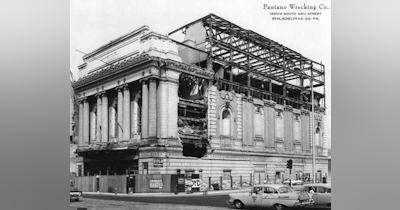Above, vacationers stroll along the Atlantic City boardwalk in front of the entrance to the Savoy theater, which was advertising a grand concert in September of 1909. It looks like the weather had turned a bit autumnal and breezy, because the people we can see were sure wearing a lot of heavy clothes for a stroll along the seaside. Below, an architectural rendering of the theater’s frontage.
The young boy below, however, seems dressed for a hot summer day at the beach as he poses for a family photograph. Behind him we can see Young’s Pier Theatre, built right out over the ocean!
Back over on the Boardwalk, the Apollo Theatre in Atlantic began as a “legitimate” stage in the early 20th Century. It took the place of the Academy of Music, which had burned down in a fire in 1902. The Apollo was one of the most popular theaters for tryout shows (though when the tide began to turn in the seaside showbiz market, it was later used as a dance hall, and then a movie theater). Here we see a photo from July of 1908, when it was hosting The Taming of Helen, starring Cecil Spooner and Edna Mays. Interestingly this show was NOT a tryout show, but had come down to Atlantic City after having been a success in New York the previous season.
That same week in the summer of 1908, a musical show called The Girl Question was opening at the Savoy Theatre in Atlantic City. In a photo from February of 1912, the marquee of the Savoy shows that the actress Henrietta Grossman was playing in a show called The Real Thing.
As we mention in the podcast episode, one of the reasons that many actors preferred to ‘try out’ their shows in Atlantic City rather than Philadelphia was the fun, easy-going atmosphere of the shore life. And it wasn’t just white theater artists who brought their shows to Atlantic City, here we see the Black musical performers Flournoy Miller, Josephine Hall, Evelyn Preer and Aubrey Lyles walking along the Boardwalk in the summer of 1923, when Blake and Sissle’s hit show Shuffle Along came down to the shore for a run.
Selected Sources for Episode 61:
Bernheim, Richard (assisted by Sara Harding and the Staff of the Labor Bureau, Inc.), The Business of the Theatre: An Economic History of the American Theatre, 1750- 1932. Prepared on Behalf of the Actors’ Equity Association, Benjamin Blom, Inc, 1932.
Brody, Richard, “What to Read and Stream: The Remarkable Out-of-Print-Book That Inspired ‘42nd Street’.” The New Yorker, May 6, 2020. https://www.newyorker.com/culture/the-front-row/what-to-read-and-stream-the-remarkable-out-of-print-book-that-inspired-42nd-street
Davis, Andrew, America's Longest Run: A History of the Walnut Street Theatre. The Pennsylvania State University Press, 2010
Grange, William. The Business of American Theatre, 2021. Internet resource.
Hornblow, Arthur. A History of the Theatre in America, from its Beginnings to the Present Time, Vol. 2. J. B. Lippincott Company, Philadelphia, PA, 1918.
Martin, Constance Barry, “Atlantic City as a Tryout Town,” PhD Thesis, University of Illinois, 1973.
Ropes, Bradford, 42nd Street. Grosset & Dunlap, 1932. (accessed online
https://www.docdroid.net/adRci8a/42nd-street-novel-pdf)
42nd Street (movie) https://archive.org/details/42ndstreet1933_201908/42nd_Street_1080.mp4
















